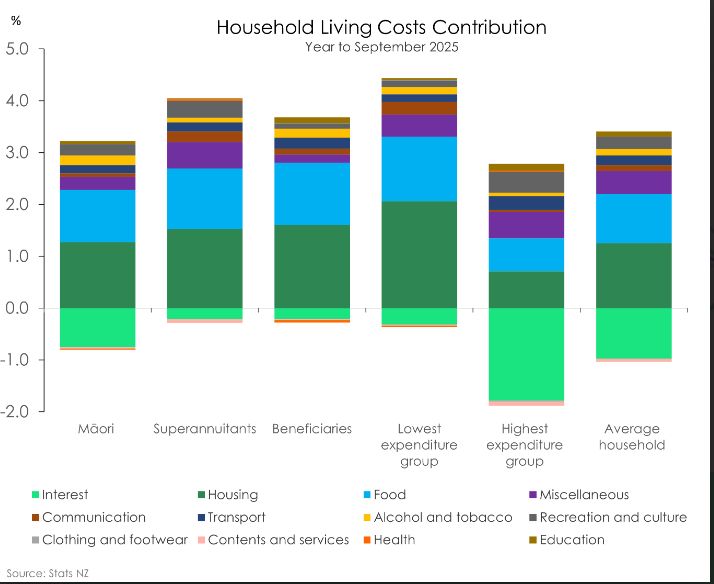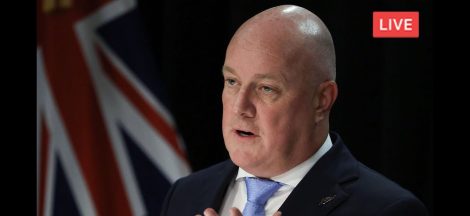- Offshore data and events drove financial markets
last week. A hawkish dissent to the Fed rate cut and a hot
Aussie inflation print saw expectations for further easing
from the Fed and RBA pared back. That repricing found its
way to Kiwi markets, with yields climbing in sympathy and
the Kiwi dollar under pressure. - The US and China
have landed on a trade deal. The average tariff rate on
Chinese imports will be reduced to under 50%. And in
exchange, China will pause its control on rare exports and
purchase more US soybeans, oil and gas. Question is: how
long will this truce last? - We really want to
highlight our most recent podcast episode “Unlocking
efficiency one robot at a time” where we join the team
at DSL logistics to get the inside scoop on how cutting-edge
robotics have transformed their Kiwi
business.
Here’s our take on current
events
We had a big week of international
announcements and data. A lot of it coming from the
US…
Highly anticipated trade talks between the US
and China seemingly went well with President Trump even
rating his meeting with President Xi a 12 out of 10. The two
parties have agreed to a one year “truce”, alleviating
trade tensions for now. Within the truce, China has agreed
to forgo its export restrictions on rare earth metals, buy
US soybeans, and undergo stricter export controls on
precursor chemicals used in the production of Fentanyl. In
exchange, Trump relaxed some of the tariffs on Chinese
imports. The average tariff rate on China is now down to 45%
(previously 55%). It’s a move in the right direction, and
certainly a better outcome than the additional 100% tariff
Trump threatened just a couple of weeks ago. But even at
45%, tariffs on China remain at levels that are likely to
weigh on China’s growth. And subsequently continues to
risk weighing on our own growth and recovery here at
home.
Advertisement – scroll to continue reading
Nevertheless, with that ticked off Trump’s
list, we hope his attention turns to addressing the ongoing
US Government shutdown. With every week that passes, the
shutdown is estimated to deduct 0.1% of annualised GDP. And
today marks day 33 of the shutdown, with the closure on the
brink of becoming the longest shutdown in US
history…
Movements in financial markets over the
last week however were centred around the US Fed. The 25bps
cut to the fed funds rate was as expected. But the decision
came with two dissents. Governor Stephen Mirran opted for a
50bps cut – big shock (not). But the Kansas City Fed
President Jeffrey Schmid voted for no change. The hawkish
dissent was unexpected and seemingly supported by commentary
from Fed chair J. Powell. In remarks during his press
conference, Powell pushed back on a predetermined 25bps cut
in December, commenting that a third consecutive cut was
“not a forgone conclusion, far from it ”. Such
comments saw a swift pare back in expectations for the
December meeting with markets going from having over a 90%
chance of a cut priced to just 50% priced in. As expected,
the pullback saw US rates across the curve jump higher. Both
the US 2yr and 5yr lifted ~10bps higher following the
announcement and press conference.
Meanwhile in
currency markets, the Kiwi lost some strength against the US
dollar as expected. Shortly after the announcement the
NZDUSD fell from around .5790 to .5752, with further falls
to a low of .5715 in the days that followed. Currently the
Kiwi Dollar sits in the low .5720’s at time of
writing.
The repricing of Aussie rate cut expectations
following a hot inflation print also spilt over to our
markets. Aussie annual inflation printed above expectations,
up 3.2% over the September quarter. The acceleration follows
the unwind in energy rebates. The disinflationary force
previously provided by goods inflation is also waning. At
the same time, there’s persistent strength in services
inflation which is still running at 3.5%.
Further
confirming that the recent reacceleration is not being
driven by one-off increases, measures of underlying price
pressures also printed hot. Trimmed mean inflation lifted to
3% on the year, climbing to the top of the RBA’s 2-3%
target band. The September inflation update is a hard one to
look through, and will have to result in a higher inflation
outlook. The RBA expected trimmed mean to fall to 2.6% by
the end of the year. That looks unlikely now. Market
reaction to the report was swift, with a strong sell-off in
Aussie rates as a rate cut this week was priced out. Some
local commentators have even called the end of the easing
cycle. Kiwi rates rose in sympathy, with the 2year swap
climbing about 20bps above the cycle low – although Friday
saw some of that lift unwind.
Last week’s moves in
Kiwi rates and currency were largely driven by offshore
developments. There has been no change to the domestic
economic outlook. We still expect the RBNZ to deliver
another 25bps at the November meeting.
This week our
attention turns to Stats NZ’s suite of labour market data
out on Wednesday. We expect that conditions in the labour
market loosened a little bit further over the quarter. In
some good news, there are signs that the market is beginning
to stabilise. 2026 should be a better year. But right here,
right now, labour demand is not yet strong enough to absorb
the extra supply entering the market. (See
our full preview here).
We expect the unemployment
rate to increase to 5.3% from 5.2% – the highest in over
eight years. Though a key assumption to the rise in the
unemployment rate is a continued drop in labour force
participation. The participation rate soared to an all-time
high of 72.4% in June 2023. A surge in migration supplied
much needed work-ready migrants, and a cost-of-living crisis
pulled many off the sidelines. But with waning demand,
workers have headed for the exits. As such, we’ve seen a
gradual decline in the participation rate. And we expect a
further fall in participation from 70.5% to 70.4% – the
lowest since Dec 2019.
At the same time, growing slack
within the labour market should also see wage growth
continue to moderate. We expect to see a 0.4% quarterly rise
in wages, pulling down the annual rate from 2.3% to
2.1%.
Altogether the data should reinforce the need
for further monetary policy easing. Downside risks to
medium-term inflation are growing given the soft labour
market and dimming global outlook. We continue to expect the
RBNZ to cut the cash rate by 25bps at the November
meeting.
Charts of the Week: Inflation’s uneven
bite: Who’s hurting most?
Inflation is hurting some
more than others. It’s unfair. StatsNZ’s Household
Living-Cost index showed that living costs for the average
Kiwi household continue to ease. But there is a widening gap
across different Kiwi households.
Living costs for the
average Kiwi household were up 2.4% in the year to September
2025, down from 2.6% last quarter. But for households in the
highest expenditure group, costs rose just 0.8%. In
contrast, those in the lowest expenditure group, saw costs
rise by 4%. Households that spend the least, and have the
tightest budgets, are experiencing the highest
inflation.
The disparities don’t stop there.
Superannuitants and beneficiaries are also feeling the pinch
with living costs rising 3.9% and 3.4% respectively. Māori
households are faring a bit better, with living costs up a
shallower 2.4%. But that’s still 3 times above the
increase of those amongst the highest spending
households.
Interest rates have been the leading
driver behind the story of who’s paying the most. From the
sharp rise over 2022-23, to the steep declines over the past
year.
With interest rates now falling, interest
repayments are down 14.3% for the average household. It’s
a move which has had a sizeable impact in reducing living
costs across all Kiwi. But one which has been felt most by
households amongst the highest expenditure group as higher
carriers of debt.
For households within the highest
expenditure group, interest repayments hold a 12% weighting
towards their cost of living. That’s almost double that
for the average household (6.8%). So when interest rates
were rising, they were hardest hit. Now, the move down is
providing relief. Interest repayments have fallen close to
15%. It’s the reason why these households are recording
the lowest annual inflation, deducting as much as 1.8% from
their cost of living.
For other groups, particularly
superannuitants and beneficiaries, the fall in interest
repayments, have had less of an impact. Repayments hold less
than a 2% weighting for both groups. Simply because these
households are less exposed to holding mortgages. For
example, according to Stats NZ, just 8.5% of Kiwi retirees
have a mortgage.
All households are feeling the pinch
of rising costs across the housing and food groups. No
surprises there. Both housing and food are two areas where
the Consumer Price Index has flashed sizeable increases in
prices over the past year. But within housing, where most of
the inflation heat is coming from, separate subgroups are
driving up living costs across Kiwi households.





